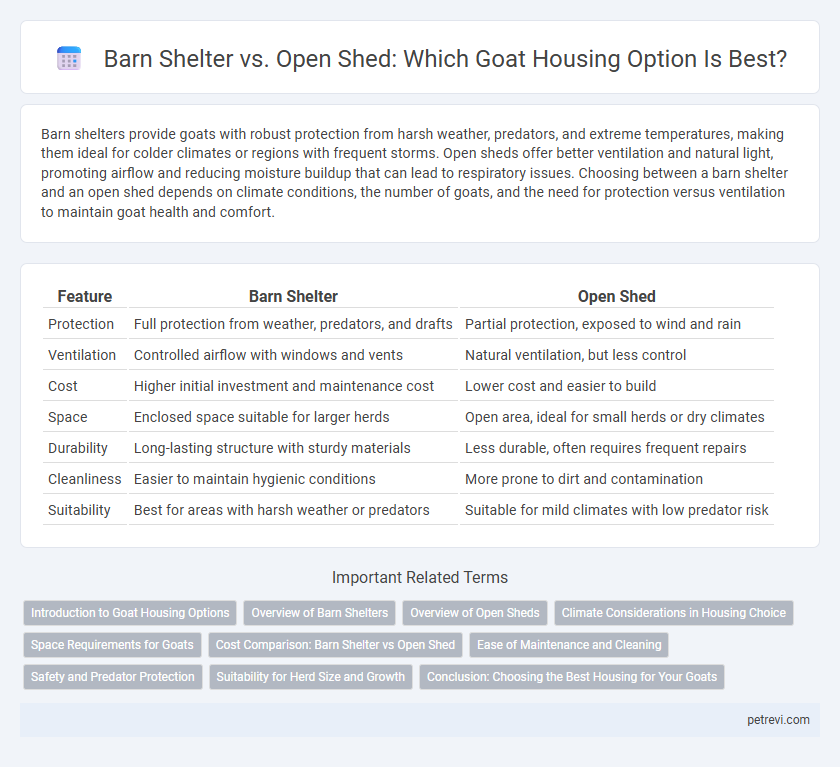Barn shelters provide goats with robust protection from harsh weather, predators, and extreme temperatures, making them ideal for colder climates or regions with frequent storms. Open sheds offer better ventilation and natural light, promoting airflow and reducing moisture buildup that can lead to respiratory issues. Choosing between a barn shelter and an open shed depends on climate conditions, the number of goats, and the need for protection versus ventilation to maintain goat health and comfort.
Table of Comparison
| Feature | Barn Shelter | Open Shed |
|---|---|---|
| Protection | Full protection from weather, predators, and drafts | Partial protection, exposed to wind and rain |
| Ventilation | Controlled airflow with windows and vents | Natural ventilation, but less control |
| Cost | Higher initial investment and maintenance cost | Lower cost and easier to build |
| Space | Enclosed space suitable for larger herds | Open area, ideal for small herds or dry climates |
| Durability | Long-lasting structure with sturdy materials | Less durable, often requires frequent repairs |
| Cleanliness | Easier to maintain hygienic conditions | More prone to dirt and contamination |
| Suitability | Best for areas with harsh weather or predators | Suitable for mild climates with low predator risk |
Introduction to Goat Housing Options
Barn shelters provide goats with enhanced protection from extreme weather, predators, and harsh environmental conditions, making them suitable for regions with severe climates. Open sheds offer better ventilation and natural light, promoting goat health and comfort in milder, temperate areas. Selecting appropriate goat housing depends on factors such as local climate, goat breed, and farm management practices to optimize animal welfare and productivity.
Overview of Barn Shelters
Barn shelters provide a controlled environment with better protection against extreme weather, predators, and pests, ensuring goat health and comfort. These structures enable efficient waste management and ventilation, which reduces respiratory issues and promotes hygiene. Properly designed barns support seasonal adaptation and facilitate easier feeding, milking, and monitoring of goats.
Overview of Open Sheds
Open sheds provide goats with adequate ventilation, reducing the risk of respiratory diseases common in poorly ventilated barns. They are typically constructed with sturdy frames and roofing materials that protect goats from harsh weather while allowing natural light. Open sheds also facilitate easier cleaning and manure management, promoting a healthier environment for goat housing.
Climate Considerations in Housing Choice
Barn shelters provide better insulation and protection against extreme weather conditions, making them ideal for goats in colder or wetter climates. Open sheds offer improved ventilation and airflow, which helps prevent heat stress and respiratory diseases in hot and humid environments. Selecting the appropriate housing based on regional climate ensures optimal goat health, comfort, and productivity.
Space Requirements for Goats
Barn shelters provide goats with enclosed, climate-controlled environments that optimize space use by allowing vertical stacking and partitioning for individual goats, enhancing comfort and reducing disease spread. Open sheds require more horizontal space to accommodate adequate ventilation and freedom of movement, often leading to larger overall floor areas per goat to prevent overcrowding and promote natural behavior. Proper measurement recommends at least 15-20 square feet per adult goat in barns and 20-25 square feet in open sheds to ensure sufficient space for resting, feeding, and social interaction.
Cost Comparison: Barn Shelter vs Open Shed
Barn shelters for goat housing generally incur higher initial construction costs due to robust materials and enhanced insulation compared to open sheds, which require minimal investment. Maintenance expenses for barns tend to be greater over time because of the complexity and size of the structure, whereas open sheds benefit from simpler upkeep and easier repairs. Despite higher costs, barn shelters offer improved protection and environmental control, potentially increasing overall goat health and productivity, while open sheds provide an economical solution suitable for milder climates.
Ease of Maintenance and Cleaning
Barn shelters offer easier maintenance and cleaning due to their enclosed structure, which protects goats from harsh weather and reduces debris accumulation. Open sheds, while allowing better ventilation, require more frequent cleaning to manage dirt and waste buildup from exposure to outdoor elements. Efficient drainage systems and smooth flooring in barn shelters further enhance sanitary conditions and simplify routine cleaning tasks.
Safety and Predator Protection
Barn shelters provide superior safety and predator protection for goats compared to open sheds by offering enclosed walls, secure doors, and elevated flooring that minimize access points for predators such as coyotes and foxes. Open sheds, while allowing better ventilation, expose goats to potential threats due to their open sides and less robust structural barriers, increasing vulnerability during nighttime or harsh weather conditions. Investing in sturdy barn shelters with reinforced materials and lockable entries ensures optimal defense against common predators and environmental hazards in goat housing.
Suitability for Herd Size and Growth
Barn shelters provide ample space, better climate control, and secure protection ideal for large goat herds experiencing rapid growth, ensuring optimal health and productivity. Open sheds suit smaller herds or those in mild climates, offering cost-effective ventilation and ease of access while accommodating moderate expansion. Selecting the appropriate structure influences herd management efficiency, animal welfare, and long-term scalability.
Conclusion: Choosing the Best Housing for Your Goats
Barn shelters offer superior protection against harsh weather, predators, and provide a controlled environment that supports goat health and productivity. Open sheds, while cost-effective and well-ventilated, may expose goats to temperature extremes and increased risk of infectious diseases. Selecting the best housing depends on climate, budget, and management goals, with barn shelters generally preferred for maximum safety and comfort.
Barn Shelter vs Open Shed for Goat Housing Infographic

 petrevi.com
petrevi.com